
by Mary Caperton Morton Monday, December 3, 2012
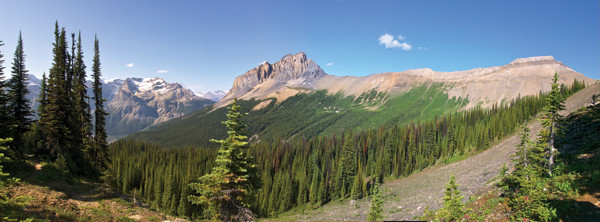
The Burgess Shale's Walcott and Raymond quarries lie on the ridge between Mount Wapta (left) and Mount Field (right), across from Burgess Mountain in Canada's Yoho National Park. Mary Caperton Morton
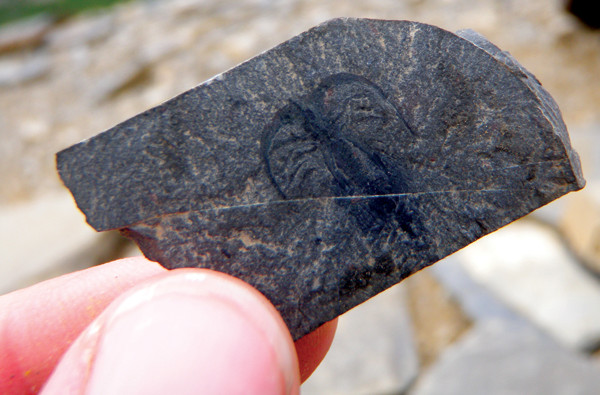
_Marella_, nicknamed the "lace crab," is the most common fossil in the Walcott Quarry. It has never been found anywhere else in the world. Mary Caperton Morton
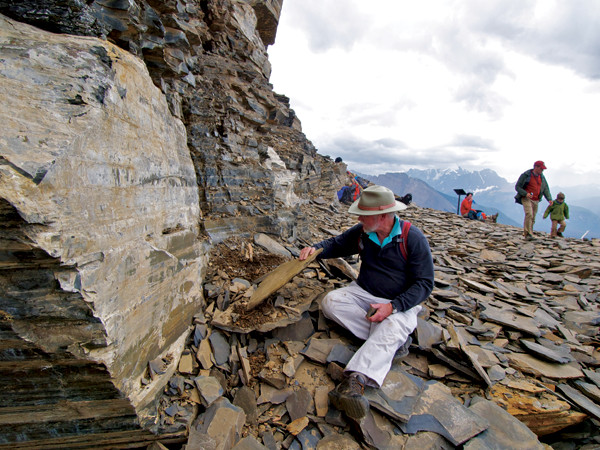
The author's father searches through slabs in the Walcott Quarry. Mary Caperton Morton
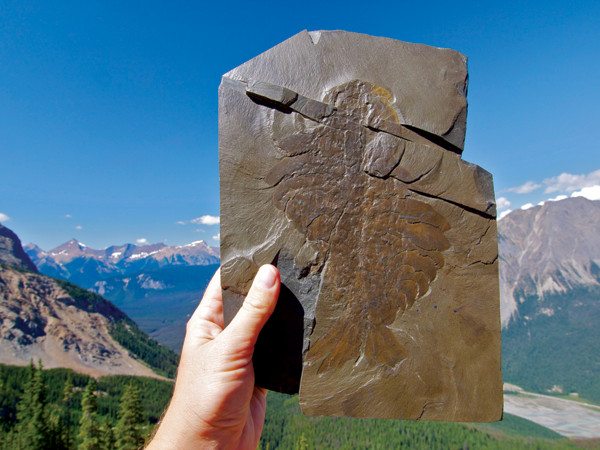
The mouth, jaws and body of Anomalocaris were originally discovered separately and thought to belong to different creatures. The whole specimen, shown here as a replica, helped knit together the formidable Cambrian predator. Mary Caperton Morton
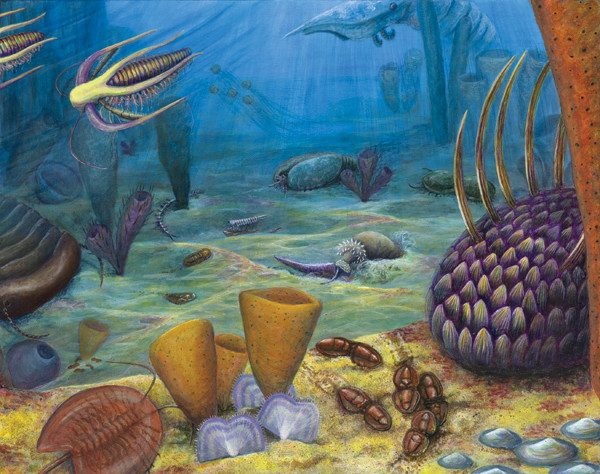
The animals of the Burgess Shale lived in calm waters on the muddy seafloor at the base of the Cathedral Escarpment a hundred meters below the sea surface, as shown in this artist's depiction. Kathleen Cantner, AGI
Of all the famous fossil localities in the world — Mongolia’s Flaming Cliffs, Tanzania’s Olduvai Gorge, Wyoming’s Green River, Germany’s Solnhöfn Quarry — perhaps none is as widely celebrated as British Columbia’s Burgess Shale. High in the Canadian Rockies, the Burgess Shale contains some of the oldest and most exquisitely detailed fossils of early life on Earth. Visiting the Burgess Shale requires some preparation — you must hire a guide and hike 22 kilometers at high elevation — but for a fossil enthusiast, the payoff is worth every step.
As a general rule, the fossil record is dominated by hard parts: shells, teeth and bones. The Burgess fossils, however, reveal so much more. Small but exquisite, the fossils preserve fine details of soft body structures like gills and eyes and even last meals: tiny trilobites encapsulated in stone, for example, deep in the visible guts of larger worm-like predators.
The Burgess Shale quarries are famous not just for the sheer number and variety of fossils and their rare and lovely preservation, but also for the window they open to the past. Multicellular life evolved on Earth about 570 million years ago with a bang known as the Cambrian Explosion, just 65 million years before the Burgess assemblage formed.
About 505 million years ago, a vast and bizarre selection of life forms swam through the Cambrian seas. Despite the fossils’ finely preserved detail, in some cases, paleontologists are still unable to distinguish tops from bottoms and heads from tails. (One especially weird specimen was formerly named Hallucigenia.)
Many modern phyla are clearly represented at the Burgess Shale, including Annelida, Chordata and Onychophora, with species from the phylum Arthropoda being most common. However, many specimens cannot be classified beyond their phylum, and some genera, like Wiwaxia, Dinomischus and Nectocaris, don’t fit into any known phylum at all. Without a clear family tree, it’s difficult to determine if many of the creatures were ancient ancestors of modern life or simply evolutionary dead ends.
For an intact 500-million-year-old soft-bodied fossil to endure is extremely rare. To be immortalized as a fossil, an organism must avoid predation, scavengers and decomposition and be preserved in an ideal environment, often through rapid burial. Then the rock stratum containing the fossil must remain pristine for millions of years, avoiding metamorphosis, compression, distortion and extreme heating. Finally, if the fossil is to be studied, it must be unearthed through erosion and, of course, discovered.
Despite the long odds, paleontologists have found Cambrian fossils at more than 30 sites around the world, including in Greenland, China and Australia. A dozen of these assemblages include soft-bodied organisms. So what was unique about the Cambrian environment, and particularly the setting of the future Burgess, that allowed such delicate fossils to form and endure? The answers lie in the chemistry of the Cambrian seas.
Half a billion years ago, the world was a different place: Days were 21 hours long, years lasted 420 days, and the landmasses were clumped together and devoid of both plants and animals. However, there was abundant life in the seas.
Most of the Burgess Shale animals lived on the seafloor; few pelagic organisms that swam in the water column are found among the well-bedded slabs of black shale. During the Middle Cambrian, the Burgess Shale quarries lay underwater just north of the equator, at the foot of a submerged limestone wall known as the Cathedral Escarpment. Scientists speculate that ocean currents continuously swept siliceous muds and sediments over the rim of the Cathedral Escarpment, where they piled in a wedge at the base of the cliffs. Occasionally, this wedge would slump downslope, quickly burying any creatures living on the seafloor at the base of the cliffs.
The mudflows would have entombed the creatures out of the reach of scavengers, but many types of decomposing microbes can still thrive in such buried, low-oxygen environments. However, the sediment that was deposited next would prove crucial. Samples collected from similar outcrops of Cambrian fossil-containing rocks around the world suggest that a carbonate cement cap may have settled over the mud layers containing the organisms soon after burial, further protecting the trove from decomposing microbes. This scenario fits with what paleontologists know about Cambrian seas: that they were enriched with calcium carbonate and relatively depleted of oxygen and sulfate, both important microbial nutrients.
Subsequent preservation of the Burgess Shale fossils required something of a perfect fossilization storm, one that only occurred in a very narrow zone. The famous quarry of fossil-rich shale is about 3 meters high and less than a city block long, bookended by metamorphically baked shale that contains no fossils. Proximity to the durable Cathedral Escarpment — remnants of which can still be seen above the quarry — is likely what saved the fossils from compaction or warping as the Canadian Rockies were uplifted during the Mesozoic.
The discovery of the Burgess Shale fossils also owes a lot to pure chance. The three main quarries, the Walcott Quarry, the Raymond Quarry and the Stephen Quarry, lie high in the rugged mountains above the tiny town of Field, British Columbia, within the boundaries of Yoho National Park.
Field was founded in 1884, when the Canadian Pacific Railway made its way through the Kicking Horse River Valley. Legend has it that railway workers occasionally picked up “stone bugs” in the valley. One of the bugs — actually a 500-million-year-old trilobite fossil — eventually made its way to R.G. McConnell, a geologist with the Geological Survey of Canada, who eventually tracked down the mother lode: a trove of trilobite fossils high on the flank of Mount Stephen, which towers above Field.
Word of the rare Cambrian fossils eventually reached Charles Walcott, an amateur paleontologist and self-taught trilobite expert who had made his way to the top of the fledgling U.S. Geological Survey and then to the head of the Smithsonian Institution. In 1907, Walcott traveled to Field and two summers later, he found another fossil-rich outcrop across the Kicking Horse Valley from the Stephen Quarry, near Mount Burgess, for which the famous shale was named. Walcott spent every summer there until 1925, two years before his death, collecting and shipping more than 65,000 specimens back to the Smithsonian.
More than 100,000 fossils have now been removed from the site — the vast majority stored in drawers at the Smithsonian and the Royal Ontario Museum — and yet many more remain. Visitors regularly find treasure after overturning just a few slabs. A lockbox at the quarry holds examples of some of the more spectacular finds. Removing fossils is prohibited, however, and a number of motion- and pressure-sensor cameras protect the UNESCO World Heritage Site from unescorted visitors and sticky-fingered fossil enthusiasts.
The trek to Walcott’s Quarry is strenuous and stunning. Starting near the impressive Takakkaw Falls in Yoho National Park, a few steep kilometers of switchbacks lead you up and over the flank of Mount Wapta, in view of the dramatically glaciated Presidential Range and the milky jade waters of Emerald Lake far below. More switchbacks then lead up to the Walcott Quarry, which lies 2,040 meters above sea level on the saddle between Mount Wapta and Mount Field and across from Mount Burgess.
A second hike, across the Kicking Horse Valley from the Walcott Quarry, leads up the side of Stephen Mountain to the trilobite-rich Stephen Quarry. This trail gains the same amount of elevation — nearly 800 meters — as the Walcott Quarry hike, but in half the distance, making for a very steep trek. Although lesser known, the Stephen Quarry is perhaps even more impressive than the Walcott Quarry. The diversity of fossils is narrower — the outcrop is dominated by trilobites — but the sheer numbers and sizes of the fossils are astounding.
The hike to the Burgess Shale is a challenge, but for a fossil enthusiast, the rewards of overturning slabs in the world’s most famous fossil quarry are well worth the trek.
© 2008-2021. All rights reserved. Any copying, redistribution or retransmission of any of the contents of this service without the expressed written permission of the American Geosciences Institute is expressly prohibited. Click here for all copyright requests.